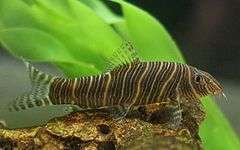Zebra loach
| Zebra loach | |
|---|---|
 | |
| Scientific classification | |
| Kingdom: | Animalia |
| Phylum: | Chordata |
| Class: | Actinopterygii |
| Order: | Cypriniformes |
| Family: | Botiidae |
| Genus: | Botia |
| Species: | B. striata |
| Binomial name | |
| Botia striata Narayan Rao, 1920 | |
The zebra loach (Botia striata) is a freshwater loach native to rivers and streams in the Western Ghats of India. The maximum size is about 9 cm (3.5 in).[2][3] It lives in tropical climate with temperature range of 21–26 °C (70–79 °F), and prefers water with 6.0 to 7.5 pH.[2]
Zebra loaches are peaceful fish suitable to community aquarium tanks. However, being bottom feeders, they may show some aggression against other smaller bottom feeders. Therefore, small corydoras are not suitable tankmates. They should be kept in groups of at least five. Any fewer and they will become stressed. They require some caves in which to hide during most of daylight. B. striata will accept a wide variety of fish foods, including live food such as blackworms, snails and small shrimps, and most commercial brands of sinking fish foods.
This species is shy, and will spend much of its time hiding. Also rarely, during times of stress it has been seen to attack smaller fish such as tetras.
According to the IUCN, the zebra loach is currently endangered in the wild due to habitat alteration combined with a small native range.[1] Aquarists interested in keeping zebra loach specimens are strongly advised to investigate the source of locally available fishes, and to only purchase those known to be captive-bred. Home aquarium breeding is unknown, but the species is bred on a commercial basis with the use of hormones.[2]
References
- "Botia striata". Integrated Taxonomic Information System. Retrieved 11 March 2006.
- Froese, Rainer, and Daniel Pauly, eds. (2005). Botia striata in FishBase. May 2005 version.
- 1 2 Chaudhry, S. (2013). "Botia striata". IUCN Red List of Threatened Species. Version 2014.1. International Union for Conservation of Nature. Retrieved 15 July 2014.
- 1 2 3 Seriouslyfish: Botia striata. Retrieved 24 June 2014.
- ↑ Kottelat, M. (2012): Conspectus cobitidum: an inventory of the loaches of the world (Teleostei: Cypriniformes: Cobitoidei). The Raffles Bulletin of Zoology, Suppl. No. 26: 1-199.
